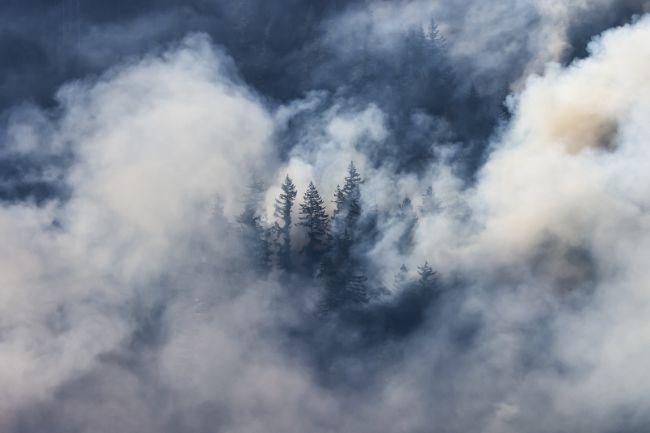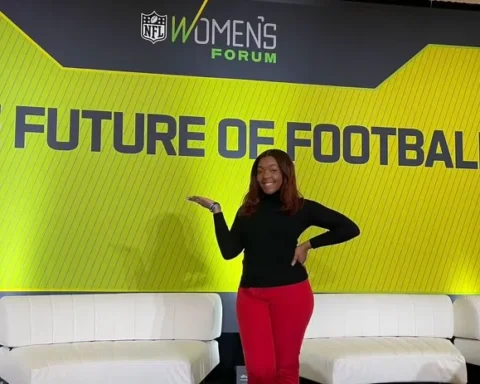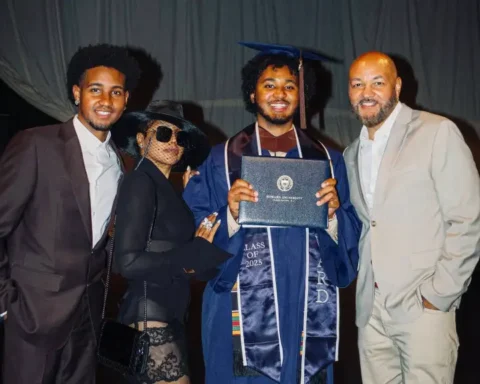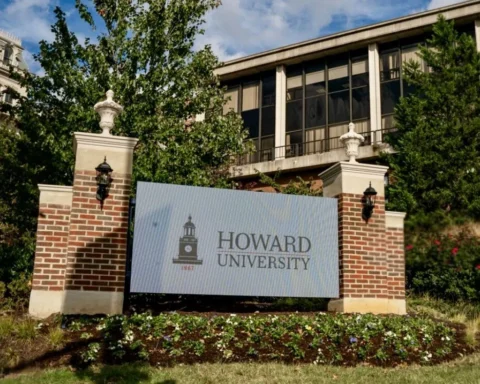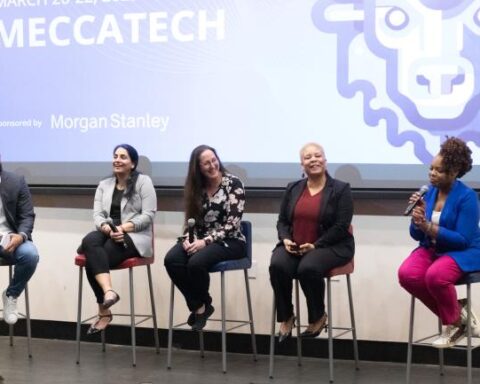By Danny Flannery
On April 7, Dr. Janelle Burke, interim chair of the Department of Earth, Environment, and Equity (E3), and assistant professors of atmospheric science Dr. Joseph Wilkins and Dr. Osinachi Ajoku hosted the Extreme Weather Symposium as part of Howard Research Month. During the event, faculty and staff from E3 presented research aimed toward the urgent challenges posed by extreme weather events spanning from Guinea to our own Washington D.C.
While welcoming attendees, Wilkins, a leading voice in fire modeling, emphasized the need for humans to learn to adapt to climate change in the face of what he refers to as the “WAL” of climate change, (rapidly increasing Water pollution, Air pollution, and Life impacts). “We need to learn how to live with the Earth,” he said, focusing on wildfires as one example. “On the Earth fire is a necessary process, but as humans we are, I would call, a fire-adverse species. We need to find a delicate balance between controlled burns and wildfire burns that works for us as well as the Earth.”
He also emphasized the interdisciplinary work that needs to be done, saying “we’re here to build collaboration, we’re here to hear new ideas, or even old ideas, and to come up with ways to better work together to tackle these challenges.”
Research across disciplines and oceans
That spirit of collaboration was apparent in the breadth of disciplines represented by the speakers, who ranged from biologists to sociologists to data scientists. The potential impact of their work was similarly wide-ranging, from better modeling of decades-long climate trends to better evacuation plans for wildfires.
Ajoku’s research, for example, focuses on aerosols — particles suspended in a liquid or gas, such as car exhaust or smoke in the atmosphere — in relation to African climate dynamics. These particles can have a massive impact on the planet, both directly by absorbing or scattering radiation from the sun and indirectly by serving as cloud condensation nuclei.
“I dare say aerosols are one of the most important science topics in the world, because when you look at every single cloud droplet, in the center of that droplet is an aerosol. There’s no such thing as precipitation, no such thing as cloud formations, without aerosols.”
Specifically, Ajoku’s research looks at how large biomass burning events in Central Africa affect the West African monsoon, the major wind system that governs the precipitation of the region. Ajoku found a major difference in cloud formation in “clean” and “dirty” days (days of more or less aerosols from burning) in the Gulf of Guinea. “We find that more aerosols led to reduced precipitation, and vice-versa, which is something that models were not capturing at all.”
With a regional population of over 200 million people, this research is invaluable in understanding the risks of flooding or drought.
Third year Ph.D. student Alycia Triplett, meanwhile, presented on her Experiential Learning and Training Opportunity at the National Oceanic and Atmospheric Administration (NOAA) Global Systems Laboratory in Boulder, Colorado. Over the summer, Triplett worked on evaluating NOAA’s Fire Weather Testbed, a platform to transition research into usable technologies, products, and communication strategies. Her work during her internship is helping to close a crucial communication gap in alerting communities to fire hazards.
“Fire warnings don’t work like your typical tornado or flash flood warning,” she explained, because according to policy fires on the ground are “considered a non-weather warning event; and therefore does not fall within the purview of national weather service operations.” This means that the National Weather Service (NWS) can only issue warnings if requested by local or state officials, which could mean delayed responses or confusion for community members in the event of an emergency.
Triplett assisted in testing the integration of fire warnings into the NWS’s Integrated Warning Teams. Typically made up of both forecasters and public officials like emergency managers, sheriffs, superintendents, and others, these teams allow meteorologists and emergency responders to better coordinate before and even during extreme weather events.
For the evaluation, four meteorologists and five land managers from California, Kansas, North Carolina, and Florida were paired to mutually confirm fires and coordinate on, and send warnings to, the public. Across seven sessions, the teams successfully coordinated on 72 simulated fires.
Social and behavioral science was woven through the evaluation through working groups, pre- and post-evaluation surveys and formal focus groups, and were the main focus of Triplett’s work. The feedback from both scientists and land managers will be invaluable to communities facing wildfires.
Focusing on community
Doctoral candidate Lauren Taylor’s talk, “After the Fire: Examining Health Disparities and Environmental Injustice in Lahaina,” explored the need to adapt to new environmental realities.
“What we’re seeing since the early 2000s is that there are around 70,000 wildfires per year, which is a lot,” said Taylor. “But what’s very interesting to me is that they’re actually not increasing. It’s actually decreasing in number, but what we’re seeing is that it’s increasing in acreage burned, as well as happening earlier. So, wildfires are no longer happening May to September, they’re moving further out.”
Her talk, examining the 2023 wildfire that devastated the community of Lahaina, Hawaii, focused on the disparities in impact and recovery. Lahaina’s poverty rate is 11.7%, far higher than both the national average and even the average of the town’s county of Maui, and concentrated in the town’s Native Hawaiian, Black, and Hispanic populations, leaving the town ill-equipped to fully recover from the fire. Over 2,000 structures were destroyed during the fire, with 86% being residential buildings and 30% of those homes being below the poverty line. Of those homes, only six have been rebuilt.
Taylor’s research illustrates that the worst impacts of extreme weather overwhelmingly fall on those with the least resources, who have contributed the least to climate change — people in poverty and those from underrepresented minority groups. Beyond a lack of resources, these communities also face greater risks due to higher rates of health complications, lack of trust toward institutions such as FEMA, and often simply a lack of knowledge of the severity of an event.
Lauryn Smith, a master’s candidate in the Department of Atmospheric Science, emphasized this last point while discussing her work modeling the 2024 Canadian wildfires, which covered D.C. in a heavy smoke in the summer of last year. Using data gathered from instruments at Howard’s Beltsville campus, Smith found significant spikes in hazardous materials including black carbon, sulfur dioxide, and carbon monoxide in the D.C. area June 6-8, 2024. These are the same dates her model showed the wildfire smoke reaching the area from Canada, led on by a low-pressure “trough” and extraordinarily dry winds blowing south into the United States.
Despite these hazardous materials, throughout Smith’s presentation are photos of people walking through smoke. During a Q&A, she said “As far as societal implications go, I see an issue with the communication of the severity of events like this. I took it seriously because I’m an atmospheric scientist, but for the people who don’t know anything, they need the education, and they need to know that they’re at stake if they go outside.”
The increase in extreme weather can seem like an insurmountable challenge, presenting urgent, compounding threats too complex to be totally understood by one person. But the researchers at Howard’s Department of Earth, Environment and Equity provide a path to possible solutions, one built on outside-the-box thinking, interdisciplinary collaboration, and strong ties to the communities most affected.
“You’ve all probably heard ‘you don’t know what you don’t know’ when someone’s trying to calm you down. I think here, though, I’d liken it more to ‘closed mouths don’t get fed,” said Triplett near the end of her talk, emphasizing the need for cooperation between disciplines, teams, and institutions. “You don’t know what you don’t know, but I bet you know a neighbor, a friend, a colleague who knows something you don’t. So why not start with them?”

